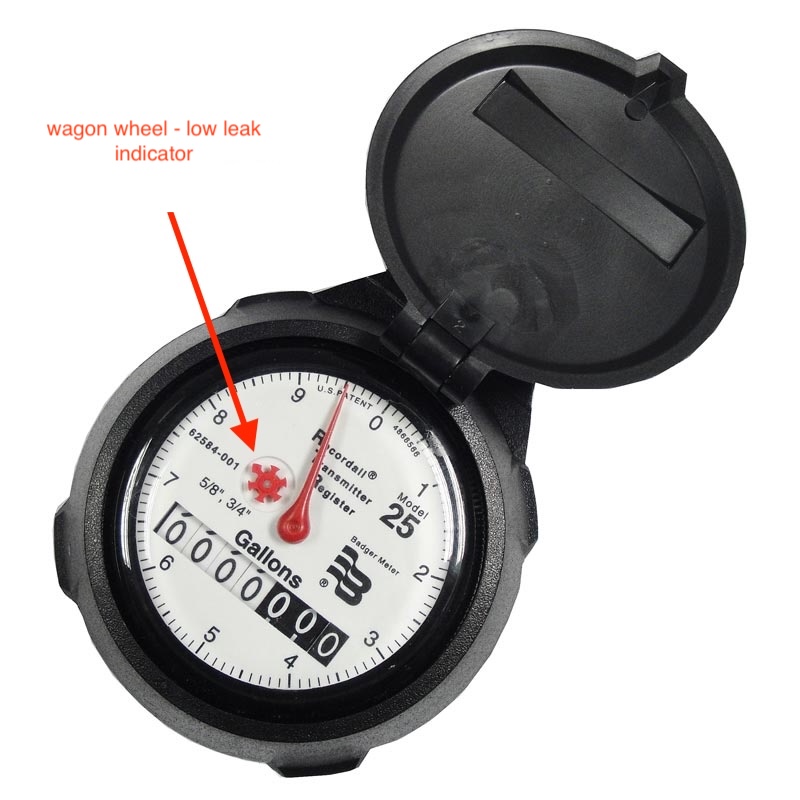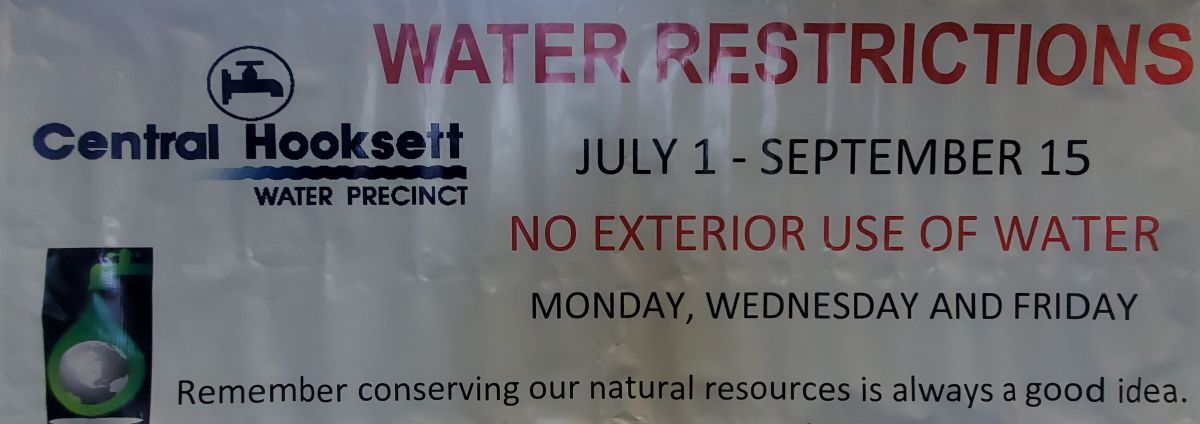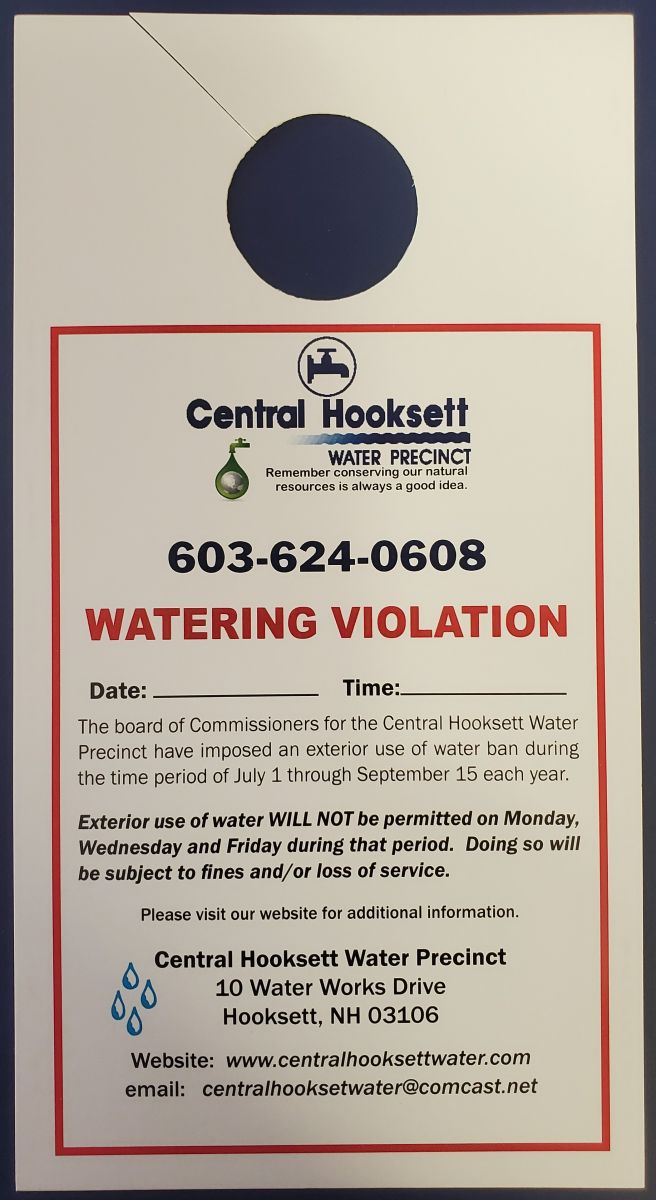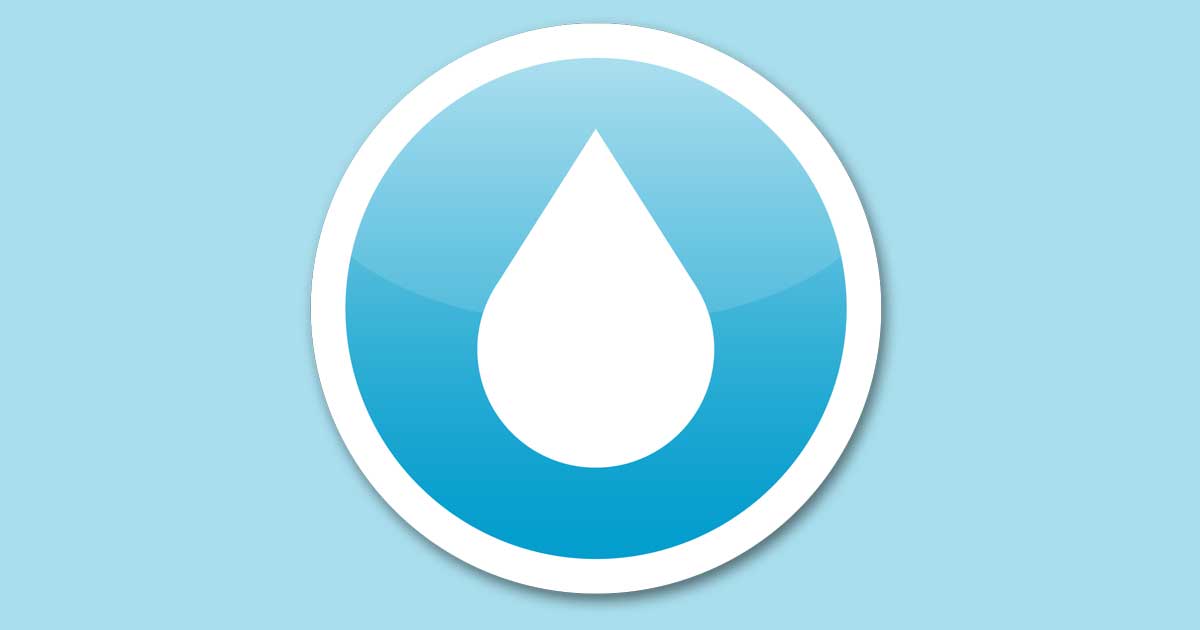To serve you better, we've assembled a list of our customers' most frequently asked questions. If you don't find your answer here, feel free to contact us. (603) 624-0608
How could I have used this much water?
A sudden increase in water usage could indicate a leak, such as a leaky toilet or faucet, which might be difficult to detect. Below are some tips to help you identify and fix potential leaks. If you cannot find a leak inside your home, contact our office, and we will investigate the issue.
Here's a breakdown of potential causes and how to address them:
- Leaky Toilet: A common culprit is a leaky toilet, often caused by a worn-out flapper or other issues in the tank.
- Leaky Faucet: Even a small drip can add up over time, so check faucets for leaks, inside and outside.
- Other Leaks: Look for signs of leaks in pipes, under sinks, or around appliances.
- Another leak indicator is located on the meter itself. If the red wagon wheel is constantly turning than there is water going thru the meter indicating a leak. This will register to a ¼ gallon a minute.
Your home's primary water meter—and irrigation meter, if you have one—is typically located in one of the following areas:
- Basement
- Crawl space
- Mechanical closet
If you're unsure where your meter is, feel free to contact us for assistance.
What A Water Meter(s) Location Looks Like

How to Check for Leaks:
Toilet:
- Visual Check: Look for water pooling around the base of the toilet or in the tank.
- Food Coloring Test: Add a few drops of food coloring to the toilet tank and wait. If the color appears in the bowl without flushing, you have a leak.
- Turn off the supply valve: Turn off the valve and wait to see if the water level in the tank drops. If it does, you have a leak.
Faucets:
- Visual Check: Look for dripping faucets or water pooling around the base.
- Listen for Sounds: Listen for unusual sounds like tapping or hissing when the faucet is off.
Pipes and Appliances:
- Visual Check: Inspect pipes and appliances for signs of leaks, such as damp areas or water stains.
- Check for Leaks Underneath: Open cabinets and remove contents to check for leaks under sinks.
What to Do:
- Fix Leaks Promptly: Address any identified leaks as soon as possible to prevent further water waste and potential damage.
- Consider Professional Help: If you're unable to locate or fix a leak yourself, consider hiring a professional plumber.
What do I do if I am experiencing low pressure?
If you're experiencing low water pressure, first check if the problem is isolated to one fixture or throughout your entire home. Check if low pressure exists on both the cold and hot water. If low pressure exists on hot water only, it would point to an issue with the hot water heater.
Here's a more detailed breakdown of what to do:
- Check with your neighbors: See if your neighbors are experiencing similar problems. If they are, the issue might be with the municipal water supply, not your plumbing.
- If it's widespread, contact the office to inquire about any known issues or planned maintenance.
Investigate Potential Causes within Your Home:
- Check for Clogs: Clogged pipes can restrict water flow and reduce pressure. Clean or replace aerators on faucets and showerheads to remove mineral deposits and debris.
- Look for Leaks: Leaks can also cause low water pressure. Inspect your plumbing for leaks, especially around pipes and fixtures.
- Inspect Pipes for Corrosion: Check plumbing pipes, especially older metal ones, for signs of corrosion. If you find corrosion, consider replacing the pipes.
- Check Valves: Ensure that all faucets are fully open and that the main shut-off valve is fully open.
If you are unsure about any of the steps: If you are not comfortable with any of the troubleshooting steps, it is always best to seek professional help.
Why is my water discolored?
Discolored water can be caused by several factors, depending on the color and whether it affects hot, cold, or both types of water. Here are some common reasons:
What to Do
- Run cold water only for a few minutes to see if it clears up. If the cold water is clear then proceed to the next step. If running the cold water and it does not clear call CHWP and report the issue. Do not proceed to the next step until the cold water is clear since you do not want to introduce any discolored water into the hot water tank.
- Check if the discoloration is in all hot water faucets or just one fixture.
- Check with neighbors to see if it’s a local issue. If they have the same issue, it’s likely a utility problem.
- Contact the office if it persists or worsens.
Brown, Red, or Yellow Water
- Rust or Sediment in Pipes – Aging iron pipes can corrode, releasing rust into the water.
- Water Main Break or Maintenance – Nearby construction, hydrant flushing, or repairs can stir up sediment.
Green or Blue Water
- Copper Pipe Corrosion – This can occur due to acidic water and may indicate plumbing issues.
Cloudy or Milky Water
- Air Bubbles – Often caused by pressure changes and usually clears up after a few minutes.
Is this affecting only hot water, cold water, or both?
If your hot water only is discolored, the most likely causes are:
- Sediment Buildup in the Water Heater
- Over time, minerals like iron and sediment can accumulate at the bottom of your water heater.
- When hot water is used, it stirs up the sediment, causing brown, yellow, or rusty water.
- Solution: Flush the water heater (if you’re comfortable doing so) or have a plumber do it.
- How to flush a water heater
- Corroding Anode Rod
- The anode rod inside your water heater protects it from rust but can corrode over time.
- A failing rod can release particles, discoloring the water.
- Solution: Contact a plumber for inspection and replacement of the anode rod if necessary.
- Old or Corroded Hot Water Pipes
- If your home has older galvanized pipes, they might be corroding, affecting only hot water.
- Solution: Contact a plumber to inspect your pipes for other causes of discoloration.
If only the cold water is discolored, here are the most likely causes:
- Rust or Sediment in Pipes
- If you have old, galvanized steel pipes, they may be corroding inside, releasing rust into the water.
- Solution: Run the cold water for a few minutes. If it clears up, the issue may be temporary. If it persists, you might need to replace aging pipes.
- Water Main Break or Maintenance
- Nearby construction, hydrant flushing, or utility work can stir up sediment in the water supply.
- Solution: Contact the office to see if there’s ongoing maintenance.
What is the Pink Residue in my Toilet and Shower?
The pink, or sometimes orange-red residue in your toilet and shower is most likely caused by Serratia marcescens, a type of airborne bacteria (it is not mold). This bacteria thrives in moist environments, especially in areas with soap scum, standing water, or mineral deposits. It is not harmful to most people but can be an irritant for those with weakened immune systems.
Causes:
- Airborne bacteria: It enters your home through the air and settles in damp areas.
- Mineral-rich water: Hard water can encourage bacterial growth.
- Soap and organic matter: The bacteria feed on soap scum, body oils, and other organic materials.
Prevention & Removal:
- Regular cleaning: Scrub affected areas with a bleach-based cleaner or a mix of vinegar and baking soda.
- Dry surfaces: Wipe down showers and sinks after use to reduce moisture.
- Improve ventilation: Use fans or open windows to reduce humidity.
- Flush toilets regularly: Standing water allows the bacteria to grow.
Cleaning Method:
Toilet Bowl & Tank
- Flush & Scrub – Use a toilet brush to scrub away the pink film.
- Apply Disinfectant – Pour ¼ cup of bleach into the toilet bowl and let it sit for 10–15 minutes.
- Avoid leaving bleach for too long as it can damage seals.
- Scrub & Flush – Scrub again and flush.
- Clean the Toilet Tank (if needed) – Add ½ cup of bleach to the tank, let it sit for 10 minutes, then flush a few times.
Shower, Sink, & Tiles
- Make a Cleaning Solution:
- Mix ½ cup bleach with 1 gallon of water (or use a disinfectant cleaner).
- Alternative: A mix of white vinegar & baking soda works if you prefer a natural option.
- Scrub Affected Areas – Use a sponge or brush to scrub the pink film.
- Let Sit for 10 Minutes – This allows the disinfectant to kill bacteria.
- Rinse Thoroughly – Wipe with clean water and dry with a towel.
- Natural Alternatives
- Distilled White Vinegar – Helps break down pink residue and prevents buildup.
- Baking Soda – Combine with vinegar for scrubbing power.
- Hydrogen Peroxide (3%) – A natural disinfectant; spray and let sit for 10 minutes.
Prevention Products:
- Scrubbing Bubbles Continuous Clean Drop-Ins – Helps prevent pink residue in the toilet tank.
- Shower Daily Spray (Method or Tilex Fresh Shower Spray) – Spritz on shower walls after each use to reduce buildup.
- DampRid Moisture Absorber – Helps control humidity in the bathroom to prevent bacteria growth.
- The Pink Stuff -The thick cleaning gel clings to the surface of your toilet, killing *99.9% of bacteria. Not only that but if used regularly (3 times per week), it reduces limescale build-up.
Why do I have a previous balance when I know I sent in my payment?
We may have received it after the due date or we may not have received it at all. Call our office and we will help you solve the problem.
Irrigation - What is a Pressure Vacuum Breaker?
A Pressure Vacuum Breaker (PVB) is a safety device that helps protect drinking water from contamination. It stops dirty water from flowing backward into clean water pipes when there is a sudden drop in water pressure. Think of it like a one-way gate that only lets water move forward.
For example, if you're using a sprinkler system to water your lawn and the town water pressure suddenly drops (maybe because a fire hydrant is in use or a water main breaks), the water in your sprinkler system could be sucked back into your home's plumbing or even the public water supply. If that water contains fertilizers, pesticides, or dirt, it could contaminate the drinking water.
A PVB prevents this by allowing air to enter the system, breaking the vacuum and stopping the backward flow of water. It’s commonly used in irrigation systems to keep drinking water safe.
CHWP will be out testing PVB's (Pressure Vacuum Breakers) annually as required by the Administrative Rules of the State of NH. There is an annual inspection fee of $50.00.
Understanding Deduct Meter to Irrigation Meter, and why the change
Effective December 31, 2022, Central Hooksett Water Precinct (CHWP) discontinued the sewer deduct meter program. CHWP would read these meters quarterly and provided the readings to the sewer department (not connected to CHWP) for billing adjustments. However, the majority of deduct meters in use were older models with exterior readers, which require manual reading by our staff.
Over the past 10 years, CHWP has upgraded all standard water meters to radio-read technology to improve efficiency, enhance accuracy, and, most importantly, reduce the risk of slips and falls for our employees. To align with these improvements, we no longer support the manual reading of sewer deduct meters.
For customers who use water for irrigation or outdoor purposes and wish to avoid sewer charges on that usage, CHWP introduced a new Irrigation Meter Policy. This will provide an updated, streamlined solution for measuring outdoor water use while ensuring accuracy and efficiency.
If you have any questions or would like more information about these changes, please contact our office.
A deduct water meter and an irrigation meter serve similar purposes but differ in how they are plumbed and billed. Irrigation meters shall be billed twice a year. August bill will include water usage for May, June and July. November bill will include water usage for August, September and October.
Deduct Water Meter
- Measures water that does not enter the sewer system, such as water used for lawn irrigation, pools, cooling towers, or industrial processes.
- Installed on a separate line after the main water meter.
- Used to subtract (deduct) this water usage from the sewer bill since sewer charges are typically based on total water consumption.
- Saves money on sewer charges for customers who use large amounts of water that never enters the sewer system.
Irrigation Meter
- Specifically measures water used for outdoor irrigation (lawns, gardens, sprinklers, etc.).
- Installed as a separate meter dedicated only to irrigation.
- Water metered through an irrigation meter is not subject to sewer charges, reducing costs for homeowners or businesses with high irrigation needs.
External Use of Water
Water Restriction Notice
Outdoor water use is prohibited on Mondays, Wednesdays, and Fridays. This irrigation ban is strictly enforced by the Central Hooksett Water Precinct (CHWP) from July 1st to September 15th or at the discretion of the Superintendent. Peak water demands are typically experienced during this time frame however should demands increase prior to July 1st due to warmer than normal temperatures with lack of precipitation, water restrictions may be imposed earlier than July 1st. These restrictions are in place in order to meet compliance with our contracted water limits from Manchester Water Works (MWW).
CHWP purchases water from MWW under a wholesale water agreement that limits us to 770,348 gallons per day. On average, our daily water use ranges from 350,000 to 400,000 gallons, well within our contractual limit. However, during summer months, we see daily demands go up as high as 900,000 gallons per day.
When we exceed 770,348 gallons per day (averaged over a 60-day period), we are charged double the rate for every excess gallon—potentially costing hundreds of thousands of dollars. To keep water rates affordable, these restrictions are necessary.
We appreciate your cooperation in conserving water and adhering to these guidelines. Thank you for helping us keep costs low for our community!
CHWP operators do patrol for any irrigation violations on the restricted days and evenings.
1st offense – written warning
2nd offense – written warning with a $100 fine
3rd offense - $300 fine and termination of water service at the time of violation. Additional fee of $50 for service to be restored if disconnected. All payments of fines shall be collected prior to the restoration of service.


